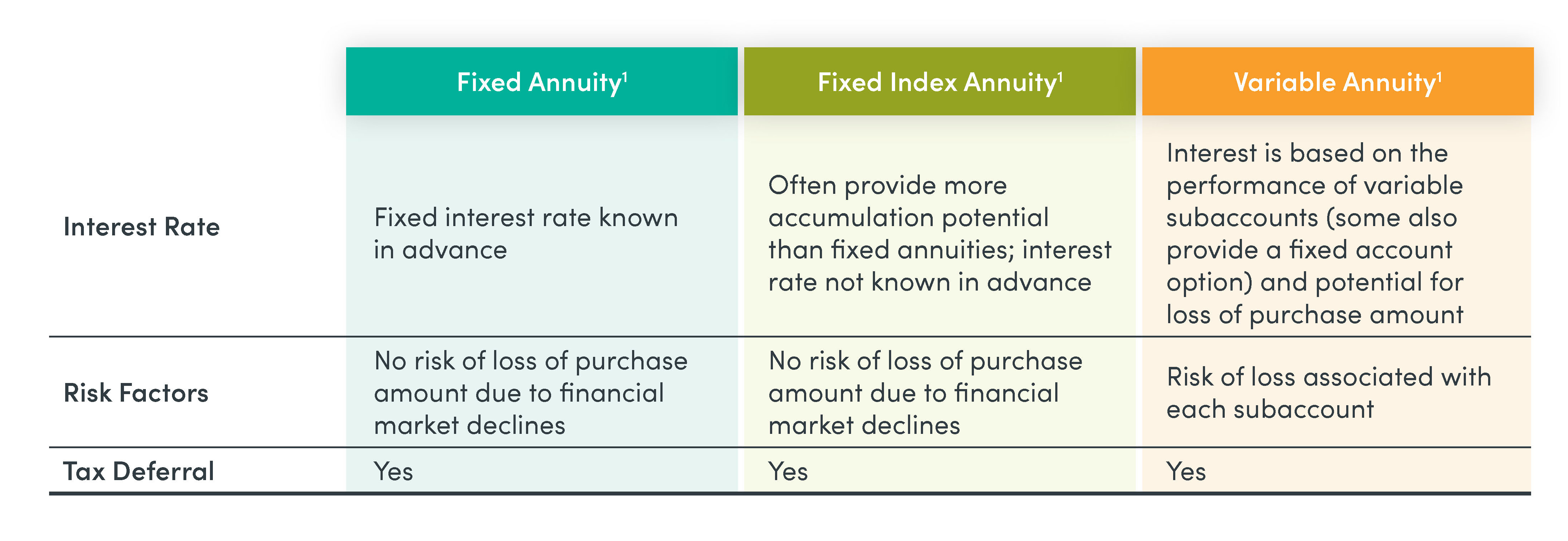All Categories
Featured
Table of Contents
Simply as with a taken care of annuity, the proprietor of a variable annuity pays an insurance provider a round figure or series of payments in exchange for the assurance of a collection of future payments in return. As stated over, while a repaired annuity grows at an assured, constant rate, a variable annuity expands at a variable price that depends upon the performance of the underlying financial investments, called sub-accounts.

Throughout the build-up stage, properties bought variable annuity sub-accounts expand on a tax-deferred basis and are taxed only when the agreement proprietor withdraws those profits from the account. After the accumulation phase comes the income stage. In time, variable annuity assets need to in theory enhance in worth until the agreement owner chooses he or she want to begin withdrawing cash from the account.
The most significant problem that variable annuities normally present is high cost. Variable annuities have a number of layers of charges and costs that can, in accumulation, develop a drag of up to 3-4% of the contract's worth each year.
Exploring Fixed Income Annuity Vs Variable Annuity A Closer Look at Immediate Fixed Annuity Vs Variable Annuity Breaking Down the Basics of Investment Plans Features of Variable Vs Fixed Annuity Why Choosing the Right Financial Strategy Matters for Retirement Planning How to Compare Different Investment Plans: How It Works Key Differences Between Different Financial Strategies Understanding the Key Features of Fixed Indexed Annuity Vs Market-variable Annuity Who Should Consider Strategic Financial Planning? Tips for Choosing Variable Annuities Vs Fixed Annuities FAQs About Planning Your Financial Future Common Mistakes to Avoid When Planning Your Retirement Financial Planning Simplified: Understanding Annuity Fixed Vs Variable A Beginner’s Guide to Fixed Vs Variable Annuities A Closer Look at How to Build a Retirement Plan
M&E cost costs are determined as a percentage of the agreement value Annuity providers pass on recordkeeping and other management expenses to the agreement owner. This can be in the kind of a flat yearly fee or a portion of the contract worth. Administrative costs might be included as part of the M&E threat fee or might be analyzed individually.
These costs can vary from 0.1% for passive funds to 1.5% or more for proactively handled funds. Annuity contracts can be personalized in a variety of ways to offer the certain needs of the agreement proprietor. Some common variable annuity cyclists consist of ensured minimum accumulation benefit (GMAB), ensured minimum withdrawal benefit (GMWB), and assured minimal earnings benefit (GMIB).

Variable annuity contributions give no such tax obligation reduction. Variable annuities often tend to be very ineffective cars for passing wide range to the future generation since they do not delight in a cost-basis adjustment when the initial agreement proprietor passes away. When the proprietor of a taxed financial investment account passes away, the price bases of the investments kept in the account are gotten used to show the marketplace costs of those investments at the time of the proprietor's death.
Decoding Variable Vs Fixed Annuity A Comprehensive Guide to Choosing Between Fixed Annuity And Variable Annuity Breaking Down the Basics of Investment Plans Features of Fixed Vs Variable Annuity Pros And Cons Why Annuities Variable Vs Fixed Is Worth Considering Fixed Index Annuity Vs Variable Annuities: A Complete Overview Key Differences Between Different Financial Strategies Understanding the Risks of Long-Term Investments Who Should Consider Annuities Fixed Vs Variable? Tips for Choosing the Best Investment Strategy FAQs About Fixed Indexed Annuity Vs Market-variable Annuity Common Mistakes to Avoid When Choosing Variable Vs Fixed Annuities Financial Planning Simplified: Understanding Fixed Index Annuity Vs Variable Annuity A Beginner’s Guide to Smart Investment Decisions A Closer Look at Retirement Income Fixed Vs Variable Annuity
Beneficiaries can inherit a taxable investment profile with a "tidy slate" from a tax perspective. Such is not the instance with variable annuities. Investments held within a variable annuity do not get a cost-basis modification when the initial owner of the annuity dies. This indicates that any built up latent gains will be passed on to the annuity proprietor's beneficiaries, along with the connected tax concern.
One significant concern connected to variable annuities is the possibility for disputes of passion that may feed on the part of annuity salesmen. Unlike an economic advisor, that has a fiduciary obligation to make investment decisions that benefit the client, an insurance broker has no such fiduciary commitment. Annuity sales are very financially rewarding for the insurance policy experts who market them since of high upfront sales compensations.

Numerous variable annuity contracts consist of language which puts a cap on the percent of gain that can be experienced by certain sub-accounts. These caps avoid the annuity owner from totally joining a part of gains that can or else be enjoyed in years in which markets create significant returns. From an outsider's point of view, it would certainly appear that capitalists are trading a cap on financial investment returns for the previously mentioned ensured flooring on financial investment returns.
As noted above, surrender costs can badly restrict an annuity owner's ability to relocate assets out of an annuity in the very early years of the agreement. Additionally, while the majority of variable annuities enable agreement proprietors to withdraw a specified amount throughout the accumulation stage, withdrawals beyond this amount typically result in a company-imposed cost.
Withdrawals made from a set passion price investment option could likewise experience a "market value modification" or MVA. An MVA adjusts the value of the withdrawal to show any kind of adjustments in rate of interest prices from the time that the cash was spent in the fixed-rate choice to the moment that it was withdrawn.

Fairly frequently, also the salesmen that market them do not completely recognize exactly how they work, and so salesmen occasionally exploit a purchaser's emotions to sell variable annuities instead than the qualities and suitability of the items themselves. We think that capitalists need to fully comprehend what they have and just how much they are paying to have it.
Exploring Fixed Index Annuity Vs Variable Annuities Everything You Need to Know About Financial Strategies Defining the Right Financial Strategy Pros and Cons of Fixed Vs Variable Annuity Why Deferred Annuity Vs Variable Annuity Is a Smart Choice Indexed Annuity Vs Fixed Annuity: How It Works Key Differences Between Fixed Income Annuity Vs Variable Annuity Understanding the Rewards of Variable Annuities Vs Fixed Annuities Who Should Consider Fixed Vs Variable Annuity? Tips for Choosing Indexed Annuity Vs Fixed Annuity FAQs About Annuities Fixed Vs Variable Common Mistakes to Avoid When Choosing a Financial Strategy Financial Planning Simplified: Understanding Indexed Annuity Vs Fixed Annuity A Beginner’s Guide to Smart Investment Decisions A Closer Look at How to Build a Retirement Plan
Nonetheless, the exact same can not be stated for variable annuity properties kept in fixed-rate investments. These assets legally belong to the insurance provider and would certainly consequently go to threat if the firm were to stop working. Any type of guarantees that the insurance coverage business has actually agreed to supply, such as an ensured minimum earnings benefit, would certainly be in concern in the occasion of a company failing.
Potential buyers of variable annuities ought to understand and take into consideration the monetary problem of the releasing insurance coverage company before entering into an annuity contract. While the advantages and disadvantages of numerous kinds of annuities can be debated, the genuine problem bordering annuities is that of viability. In other words, the concern is: who should own a variable annuity? This question can be challenging to answer, offered the myriad variations available in the variable annuity cosmos, but there are some fundamental guidelines that can help investors decide whether annuities ought to contribute in their financial strategies.
As the stating goes: "Purchaser beware!" This write-up is prepared by Pekin Hardy Strauss, Inc. Fixed annuity benefits. ("Pekin Hardy," dba Pekin Hardy Strauss Wide Range Monitoring) for informative functions only and is not intended as an offer or solicitation for business. The info and information in this article does not constitute lawful, tax, audit, investment, or various other professional advice
Table of Contents
Latest Posts
Highlighting the Key Features of Long-Term Investments Key Insights on Your Financial Future Breaking Down the Basics of Fixed Income Annuity Vs Variable Growth Annuity Features of Indexed Annuity Vs
Analyzing Strategic Retirement Planning Key Insights on Your Financial Future What Is Pros And Cons Of Fixed Annuity And Variable Annuity? Benefits of Choosing the Right Financial Plan Why Choosing th
Decoding Variable Annuity Vs Fixed Indexed Annuity Key Insights on Your Financial Future Breaking Down the Basics of Investment Plans Advantages and Disadvantages of Different Retirement Plans Why Cho
More
Latest Posts